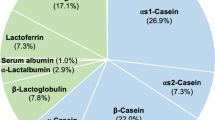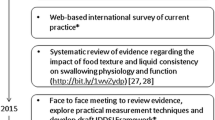Abstract
Data on normal defaecation patterns in relation to diet during the first months of infancy are very limited. We therefore investigated in a prospective study faecal weight and gastro-intestinal passage time of breast fed (n=12) and formula fed (n=14) male infants. These were studied in 72 h collecting periods at the age of 17, 35, 57, 87 and 113 (±4) days. Breast fed infants had a significantly lower daily dry faecal weight than formula fed infants in all periods investigated (median at the age of 113 days: 0.28 (0.17–0.75) g/kg and 0.81 (0.22–1.2) g/kg, respectively). Breast fed infants showed a large variation of gastro-intestinal passage time (6.79 h [range: 1.79–13.38 h] at the age of 17 days, 21.84 h [range: 5.41–75 h] at the age of 113 days). Comparable values of formula red infants were 13.75 h (range: 7.13–35.25 h) and 17.42 h (range: 5.38–36.5 h). Despite the efforts of approximation of infant formula to breast milk, differences of defaecation patterns in relation to diet are still relevant at this age and have to be considered in clinical practice.
Similar content being viewed by others
References
Adam A (1954) Verdaung und Darmbakterien. In: Brock J (ed) Biologische Daten für den Kinderarzt, 2nd edn. Springer, Berlin Heidelberg New York, pp 553–651
De Curtis M, Kempson C, Ventura V, Carter N, Mc Intosh N (1990) The relationship between fecal fat and water in very low-birth-weight infants. J Pediatr Gastroenterol Nutr 11:63–65
Fomon SJ, Filer LJ (1974) Milks and formulas. In: Fomon SJ (ed) Infant nutrition. W.B. Saunders, Philadelphia, pp 359–407
Fontana M, Bianchi C, Cataldo F, Conti Nibali S, Cucchiara S, Gobio Casali L, Iacona G, Sanfilippo M, Torre G (1989) Bowel frequency in healthy children. Acta Paediatr Scand 78:682–684
Grütte FK, Schulze J, Zunft HJ, Müller-Beuthow W, Gärtner H, Haenel H (1987) Die mikroökologische Wirkung der Frauenmlich. Die Nahrung 31:413–419
Kahn W (1921) Über die Dauer der Darmpassage im Säuglingsalter. Z Kinderheilkd 20:321–330
Lemoh JN, Brooke OH (1979) Frequency and weight of normal stools in infancy. Arch Dis Child 54:719–720
Parmar V, Abdulrazzaq YM, Brooke AG (1986) Stool water in preterm neonates. Arch Dis Child 61:1136–1137
Russel G, Costalos C, Thom H (1984) The effect of a glucose polymer mixture (caloreen) on stool composition in normal neonates. Eur J Pediatr 143:32–34
Weaver LT (1988) Bowel habit from birth to old age. J Pediatr Gastroenterol Nutr 7:637–640
Weaver LT, Ewing G, Taylor LC (1988) The bowel habit of milk-fed infants. J Pediatr Gastroenterol Nutr 7:568–571
Author information
Authors and Affiliations
Additional information
These data have been presented in part at the 26th Scientific Meeting of the German Society of Nutrition, Bonn, 6–7 April 1989.
Rights and permissions
About this article
Cite this article
Sievers, E., Oldigs, H.D., Schulz-Lell, G. et al. Faecal excretion in infants. Eur J Pediatr 152, 452–454 (1993). https://doi.org/10.1007/BF01955910
Received:
Accepted:
Issue Date:
DOI: https://doi.org/10.1007/BF01955910




